Influence of Nano-SiO2 Content on Cement Paste and the Interfacial Transition Zone
Abstract
:1. Introduction
2. Experimental
2.1. Materials
2.2. Specimen Preparation
2.3. Experimental Procedure
2.3.1. Flowability
2.3.2. Axial Compression Test
2.3.3. Basics of DIC
2.3.4. SEM
3. Results and Discussion
3.1. Influence of NS Content on the Flowability
3.2. DIC Analysis
3.2.1. Elastic Modulus of the Cement Paste with NS
3.2.2. Elastic Modulus of the ITZ with NS
3.2.3. Thickness of the ITZ with NS
3.3. SEM Analysis
4. Conclusions
- The flowability of the cement paste decreased continuously, as the NS content increased, under the condition of superplasticizer and ultrasonic treatment. Comparing the flowability of the NS0 and NS2, the value decreased from 312.2 mm to 112.8 mm. In the content range of 0.5–1%, the flowability showed good working performance.
- NS can effectively improve the mechanical properties of cement paste. When the NS content was 1%, the elastic modulus increased the most, about 73.50%, compared with Group NS0. The maximum value among them was 20.95 GPa from group NS1. When the content exceeded 1%, the elastic modulus slightly decreased.
- For the ITZ, NS can greatly promote its mechanical properties. When 1.0% NS was incorporated, its elastic modulus increased by 90.50%. The maximum value is 3.20 GPa, also from NS1. However, NS content has no significant effect on the thickness of the ITZ, and the thickness value was in the range of 76.91–91.38 μm.
- SEM confirmed that NS densified the microstructure of the cement paste and the ITZ. Compared with the cement paste, the porous structure around the sand grains was more obvious. The cement paste gradually became dense with the increase in the distance from the sand particle’s surface.
Author Contributions
Funding
Institutional Review Board Statement
Informed Consent Statement
Data Availability Statement
Acknowledgments
Conflicts of Interest
References
- Sunantha, B.; Patel, J.; Poojalakshmi, E.S.; Sudhakumar, J.; Ramaswamy, K.; Khan, R.A.; Nair, P.S.; Thomas, B. A comprehensive review on the properties of engineered cementitious composite with a self-healing material. Mater. Today Proc. 2023, in press. [Google Scholar] [CrossRef]
- Bhatta, D.P.; Singla, S.; Garg, R. Experimental investigation on the effect of Nano-silica on the silica fume-based cement composites. Mater. Today Proc. 2022, 57, 2338–2343. [Google Scholar] [CrossRef]
- Du, H.J.; Du, S.H.; Liu, X.M. Durability performances of concrete with nano-silica. Constr. Build. Mater. 2014, 73, 705–712. [Google Scholar] [CrossRef]
- Song, J.; Li, Y.; Xu, W.; Liu, H.; Lu, Y. Inexpensive and non-fluorinated superhydrophobic concrete coating for anti-icing and anti-corrosion. J. Colloid Interface Sci. 2019, 541, 86–92. [Google Scholar] [CrossRef] [PubMed]
- Yin, B.; Xu, T.; Hou, D.; Zhao, E.; Hua, X.; Han, K.; Zhang, Y.; Zhang, J. Superhydrophobic anticorrosive coating for concrete through in-situ bionic induction and gradient mineralization. Constr. Build. Mater. 2020, 257, 119510. [Google Scholar] [CrossRef]
- Reches, Y. Nanoparticles as concrete additives: Review and perspectives. Constr. Build. Mater. 2018, 175, 483–495. [Google Scholar] [CrossRef]
- Bai, S.; Guan, X.C.; Li, H.; Ou, J.P. Effect of the specific surface area of nano-silica particle on the properties of cement paste. Powder Technol. 2021, 392, 680–689. [Google Scholar] [CrossRef]
- Wang, X.; Dong, S.; Ashour, A.; Zhang, W.; Han, B. Effect and mechanisms of nanomaterials on interface between aggregates and cement mortars. Constr. Build. Mater. 2020, 240, 117942. [Google Scholar] [CrossRef]
- Joshaghani, A.; Balapour, M.; Mashhadian, M.; Ozbakkaloglu, T. Effects of nano-TiO2, nano-Al2O3, and nano-Fe2O3 on rheology, mechanical and durability properties of self-consolidating concrete (SCC): An experimental study. Constr. Build. Mater. 2020, 245, 118444. [Google Scholar] [CrossRef]
- Chen, J.; Kou, S.; Poon, C. Hydration and properties of nano-TiO2 blended cement composites. Cem. Concr. Compos. 2012, 34, 642–649. [Google Scholar] [CrossRef]
- Gao, Y.; Jing, H.W.; Zhao, Z.L.; Shi, X.S.; Li, L. Influence of ultrasonication energy on reinforcing-roles of CNTs to strengthen ITZ and corresponding anti-permeability properties of concrete. Constr. Build. Mater. 2021, 303, 124451. [Google Scholar] [CrossRef]
- Zhu, X.Y.; Gao, Y.; Dai, Z.W.; Corr, D.J.; Shah, S.P. Effect of interfacial transition zone on the Young’s modulus of carbon nanofiber reinforced cement concrete. Cem. Concr. Res. 2018, 107, 49–63. [Google Scholar] [CrossRef]
- Sharkawi, A.M.; Abd-Elaty, M.A.; Khalifa, O.H. Synergistic influence of micro-nano silica mixture on durability performance of cementious materials. Constr. Build. Mater. 2018, 164, 579–588. [Google Scholar] [CrossRef]
- Quercia, G.; Spiesz, P.; Hüsken, G.; Brouwers, H. Scc modification by use of amorphous nano-silica. Cem. Concr. Compos. 2014, 45, 69–81. [Google Scholar] [CrossRef]
- Zhang, P.; Sha, D.; Li, Q.; Zhao, S.; Ling, Y. Effect of nano silica particles on impact resistance and durability of concrete containing coal fly ash. Nanomaterials 2021, 11, 1296. [Google Scholar] [CrossRef] [PubMed]
- Aleem, S.A.E.; Heikal, M.; Morsi, W.M. Hydration characteristic, thermal expansion and microstructure of cement containing nano-silica. Constr. Build. Mater. 2014, 59, 151–160. [Google Scholar] [CrossRef]
- Gong, J.; Zhu, L.; Li, J.; Shi, D. Silica Fume and Nanosilica Effects on Mechanical and Shrinkage Properties of Foam Concrete for Structural Application. Adv. Mater. Sci. Eng. 2020, 2020, 3963089. [Google Scholar] [CrossRef]
- Wu, Z.; Shi, C.; Khayat, K.H.; Wan, S. Effects of different nanomaterials on hardening and performance of ultra-high strength concrete (UHSC). Cem. Concr. Compos. 2016, 70, 24–34. [Google Scholar] [CrossRef]
- Gdoutos, E.E.; Konsta-Gdoutos, M.S.; Danoglidis, P.A. Portland cement mortar nanocomposites at low carbon nanotube and carbon nanofiber content: A fracture mechanics experimental study. Cem. Concr. Compos. 2016, 70, 110–118. [Google Scholar] [CrossRef]
- Du, X.L.; Jin, L.; Ma, G.W. A meso-scale numerical method for the simulation of chloride diffusivity in concrete. Finite Elem. Anal. Des. 2014, 85, 87–100. [Google Scholar] [CrossRef]
- Wang, J.M.; Jivkov, A.P.; Li, Q.M.; Engelberg, D.L. Experimental and numerical investigation of mortar and ITZ parameters in meso-scale models of concrete. Theor. Appl. Fract. Mec. 2020, 109, 102722. [Google Scholar] [CrossRef]
- Maleki, M.; Rasoolan, I.; Khajehdezfuly, A.; Jivkov, A.P. On the effect of ITZ thickness in meso-scale models of concrete. Constr. Build. Mater. 2020, 258, 119639. [Google Scholar] [CrossRef]
- SKim, M.; Al-Rub, R.K.A. Meso-scale computational modeling of the plastic-damage response of cementitious composites. Cem. Concr. Res. 2011, 41, 339–358. [Google Scholar] [CrossRef]
- Liu, Q.F.; Easterbrook, D.; Yang, J.; Li, L.Y. A three-phase, multi-component ionic transport model for simulation of chloride penetration in concrete. Eng. Struct. 2015, 86, 122–133. [Google Scholar] [CrossRef]
- Xiao, J.Z.; Li, W.G.; Corr, D.J.; Shah, S.P. Effects of interfacial transition zones on the stress–strain behavior of modeled recycled aggregate concrete. Cem. Concr. Res. 2013, 52, 82–99. [Google Scholar] [CrossRef]
- Scrivener, K.L.; Crumbie, A.K.; Laugesen, P. The interfacial transition zone (ITZ) between cement paste and aggregate in concrete. Interface Sci. 2004, 12, 411–421. [Google Scholar] [CrossRef]
- Wang, C.; Zhang, M.Y.; Wang, Q.C.; Dai, J.P.; Luo, T.; Pei, W.S.; Melnikov, A.; Zhang, Z. Research on the influencing mechanism of nano-silica on concrete performances based on multi-scale experiments and micro-scale numerical simulation. Constr. Build. Mater. 2022, 318, 125873. [Google Scholar] [CrossRef]
- Reches, Y.; Thomson, K.; Helbing, M.; Kosson, D.S.; Sanchez, F. Agglomeration and reactivity of nanoparticles of SiO2, TiO2, Al2O3, Fe2O3 and clays in cement pastes and effects on compressive strength at ambient and elevated temperatures. Constr. Build. Mater. 2018, 167, 860–873. [Google Scholar] [CrossRef]
- Li, W.G.; Long, C.; Tam, V.W.; Poon, C.S.; Duan, W.H. Effects of nano-particles on failure process and microstructural properties of recycled aggregate concrete. Constr. Build. Mater. 2017, 142, 42–50. [Google Scholar] [CrossRef]
- Rupasinghe, M.; Mendis, P.; Ngo, T.; Nguyen, T.N.; Sofi, M. Compressive strength prediction of nano-silica incorporated cement systems based on a multiscale approach. Mater. Des. 2017, 115, 379–392. [Google Scholar] [CrossRef]
- Grzeszczyk, S.; Jurowski, K.; Bosowska, K.; Grzymek, M. The role of nanoparticles in decreased washout of underwater concrete. Constr. Build. Mater. 2019, 203, 670–678. [Google Scholar] [CrossRef]
- Zhang, M.H.; Li, H. Pore structure and chloride permeability of concrete containing nano-particles for pavement. Constr. Build. Mater. 2011, 25, 608–616. [Google Scholar] [CrossRef]
- Lahayne, O.; Zelaya-Lainez, L.; Buchner, T.; Eberhardsteiner, J.; Füssl, J. Influence of nanoadditives on the Young’s modulus of cement. Mater. Today Proc. 2022, 62, 2488–2494. [Google Scholar] [CrossRef]
- Xu, J.; Wang, B.B.; Zuo, J.Q. Modification effects of nanosilica on the interfacial transition zone in concrete: A multiscale approach. Cem. Concr. Compos. 2017, 81, 1–10. [Google Scholar] [CrossRef]
- Qudoos, A.; Rehman, A.; Kim, H.G.; Ryou, J.S. Influence of the surface roughness of crushed natural aggregates on the microhardness of the interfacial transition zone of concrete with mineral admixtures and polymer latex. Constr. Build. Mater. 2018, 168, 946–957. [Google Scholar] [CrossRef]
- Gu, X.L.; Hong, L.; Wang, Z.L.; Lin, F. Experimental study and application of mechanical properties for the interface between cobblestone aggregate and mortar in concrete. Constr. Build. Mater. 2013, 46, 156–166. [Google Scholar] [CrossRef]
- GB/T 17671-2021; Test Method of Cement Mortar Strength. National Standards of People’s Republic of China: Beijing, China, 2021.
- Zhang, S.F.; Liu, R.G.; Lu, C.H.; Gao, Y.; Xu, J.J.; Yao, L.; Chen, Y. Application of digital image correlation to study the influence of the water/cement ratio on the interfacial transition zone in cement-based materials. Constr. Build. Mater. 2023, 367, 130167. [Google Scholar] [CrossRef]
- Zhao, M.; Zhang, X.; Zhang, Y.J. Effect of free water on the flowability of cement paste with chemical or mineral admixtures. Constr. Build. Mater. 2016, 111, 571–579. [Google Scholar] [CrossRef]
- GB/T 8077-2012; Methods for Testing Uniformity of Concrete Admixture. National Standards of People’s Republic of China: Beijing, China, 2012.
- Pan, B.; Xie, H.M. Full-field strain measurement based on least-square fitting of local displacement for digital image correlation method. Acta Opt. Sin. 2007, 27, 1980–1986. (In Chinese) [Google Scholar]
- Pan, B.; Qian, K.M.; Xie, H.M.; Asundi, A. Two-dimensional digital image correlation for in-plane displacement and strain measurement: A review. Meas. Sci. Technol. 2009, 20, 062001. [Google Scholar] [CrossRef]
- Kong, D.Y.; Corr, D.J.; Hou, P.K.; Yang, Y.; Shah, S.P. Influence of colloidal silica sol on fresh properties of cement paste as compared to nano-silica powder with agglomerates in micron-scale. Cem. Concr. Compos. 2015, 63, 30–41. [Google Scholar] [CrossRef]
- Kong, D.Y.; Su, Y.; Du, X.F.; Yang, Y.; Wei, S.; Shah, S.P. Influence of nano-silica agglomeration on fresh properties of cement pastes. Constr. Build. Mater. 2013, 43, 557–562. [Google Scholar] [CrossRef]
- Pourjavadi, A.; Fakoorpoor, S.M.; Hosseini, P.; Khaloo, A. Interactions between superabsorbent polymers and cement-based composites incorporating colloidal silica nanoparticles. Cem. Concr. Compos. 2013, 37, 196–204. [Google Scholar] [CrossRef]
- Li, Q.C.; Fan, Y.F. Rheological evaluation of nano-metakaolin cement pastes based on the water film thickness. Constr. Build. Mater. 2022, 324, 126517. [Google Scholar] [CrossRef]
- Shen, P.; Lu, L.; He, Y.; Wang, F.; Hu, S. The effect of curing regimes on the mechanical properties, nano-mechanical properties and microstructure of ultrahigh performance concrete. Cem. Concr. Res. 2019, 118, 1–13. [Google Scholar] [CrossRef]
- Foley, E.M.; Kim, J.J.; Reda Taha, M.M. Synthesis and nano-mechanical characterization of calcium-silicate-hydrate (C-S-H) made with 1.5 CaO/SiO2 mixture. Cem. Concr. Res. 2012, 42, 1225–1232. [Google Scholar] [CrossRef]
- Wang, X.L.; Gong, C.C.; Lei, J.G.; Dai, J.; Lu, L.C.; Cheng, X. Effect of silica fume and nano-silica on hydration behavior and mechanism of high sulfate resistance Portland cement. Constr. Build. Mater. 2021, 279, 122481. [Google Scholar] [CrossRef]
- Xu, J.; Corr, D.J.; Shah, S.P. Nanomechanical investigation of the effects of nanoSiO2 on C-S-H gel/cement grain interfaces. Cem. Concr. Compos. 2015, 61, 7–17. [Google Scholar] [CrossRef]
- Gao, Y.; Yu, Z.; Chen, W.; Yin, Q.; Wu, J.; Wang, W. Recognition of rock materials after high-temperature deterioration based on SEM images via deep learning. J. Mater. Res. Technol. 2023, 25, 273–284. [Google Scholar] [CrossRef]
- Lothenbach, B.; Scrivener, K.; Hooton, R.D. Supplementary cementitious materials. Cem. Concr. Res. 2011, 41, 1244–1256. [Google Scholar] [CrossRef]
- Aghaee, K.; Khayat, K.H. Effect of internal curing and shrinkage-mitigating materials on microstructural characteristics of fiber-reinforced mortar. Constr. Build. Mater. 2023, 386, 131527. [Google Scholar] [CrossRef]
- Nandhini, K.; Ponmalar, V. Investigation on nano-silica blended cementitious systems on the workability and durability performance of self-compacting concrete. Mater. Express 2020, 10, 10–20. [Google Scholar] [CrossRef]
- Sun, Z.H.; Garboczi, E.J.; Shah, S.P. Modeling the elastic properties of concrete composites: Experiment, differential effective medium theory and numerical simulation. Cem. Concr. Compos. 2007, 29, 22–38. [Google Scholar] [CrossRef]
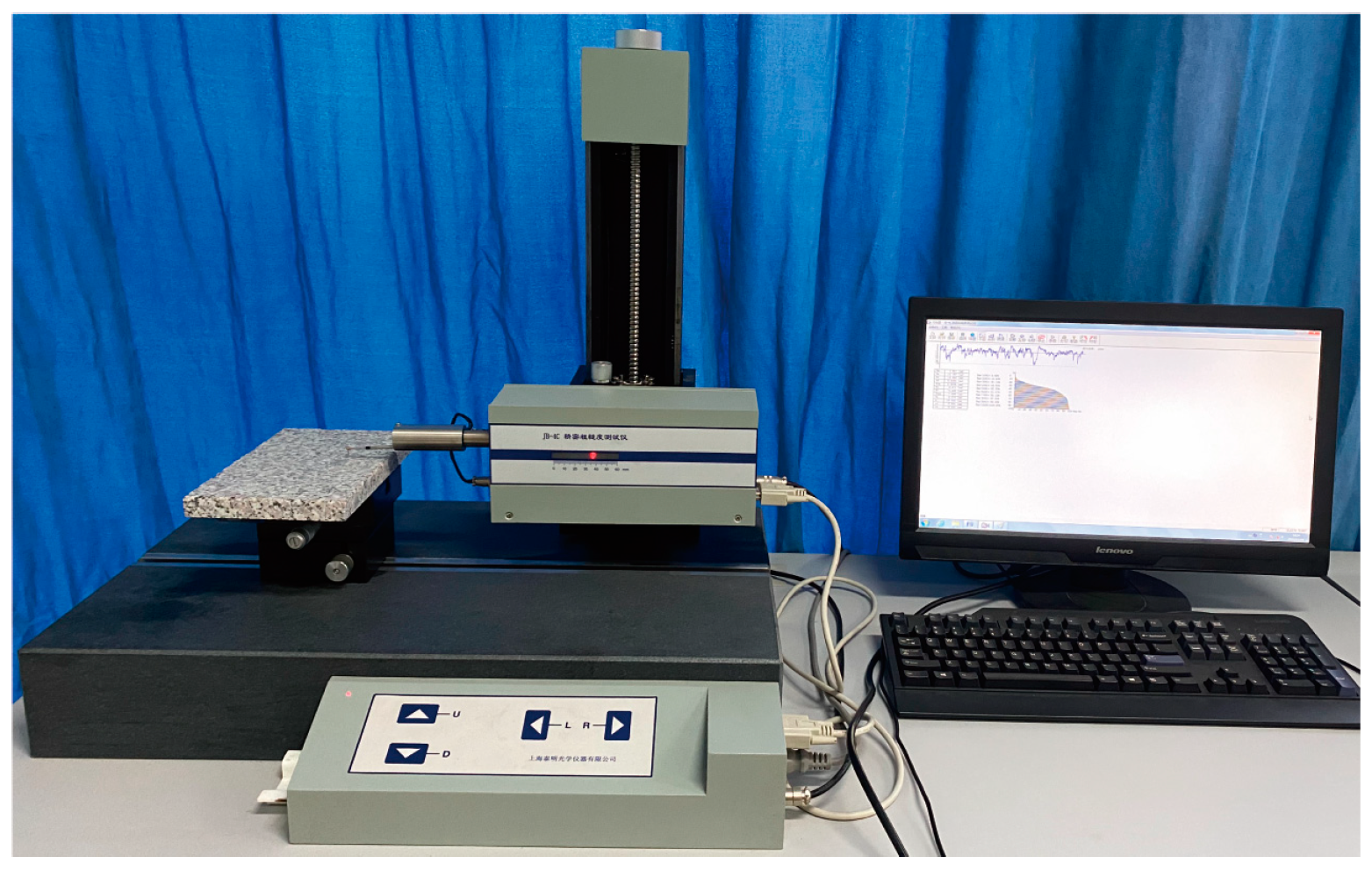
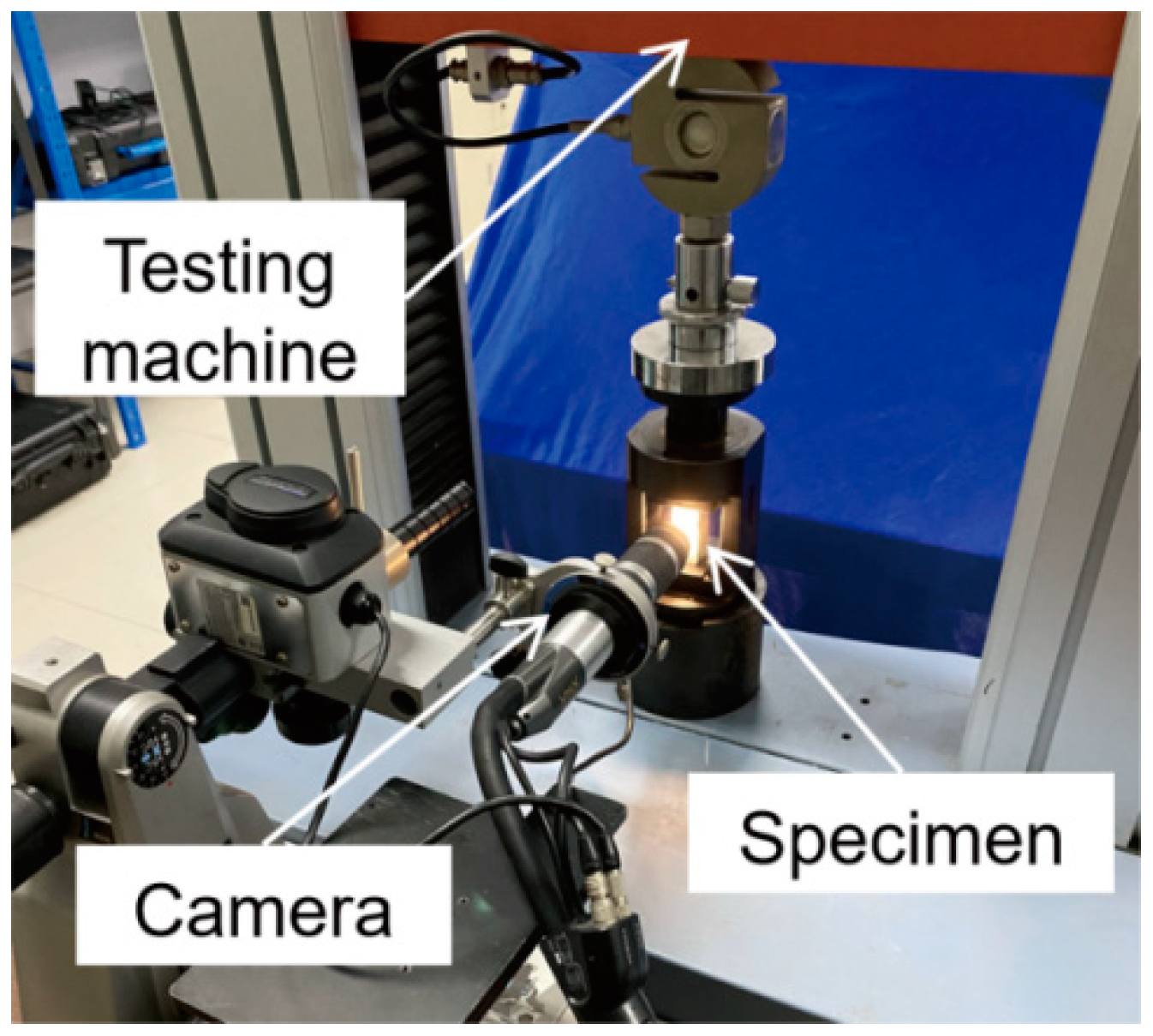
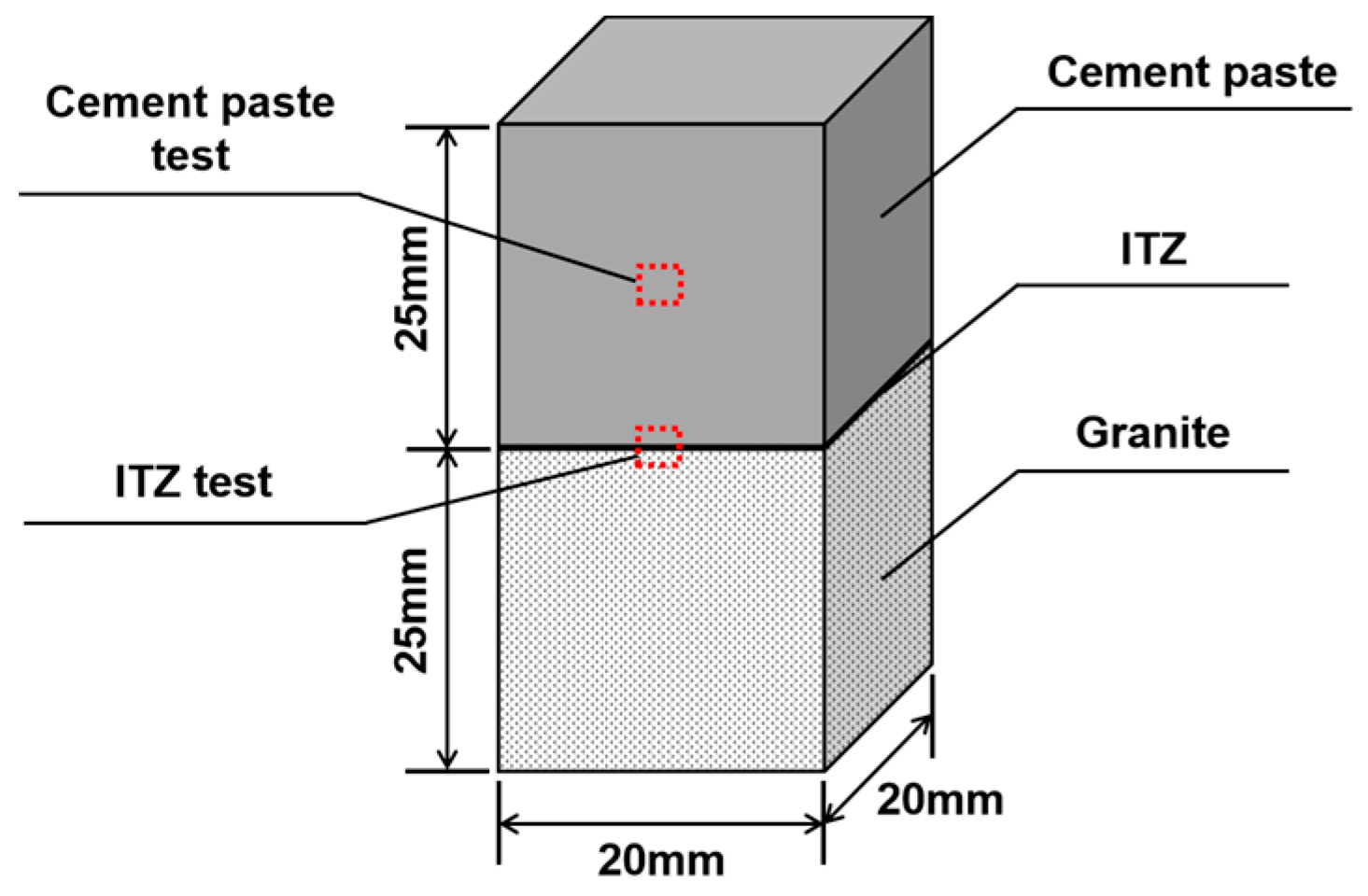
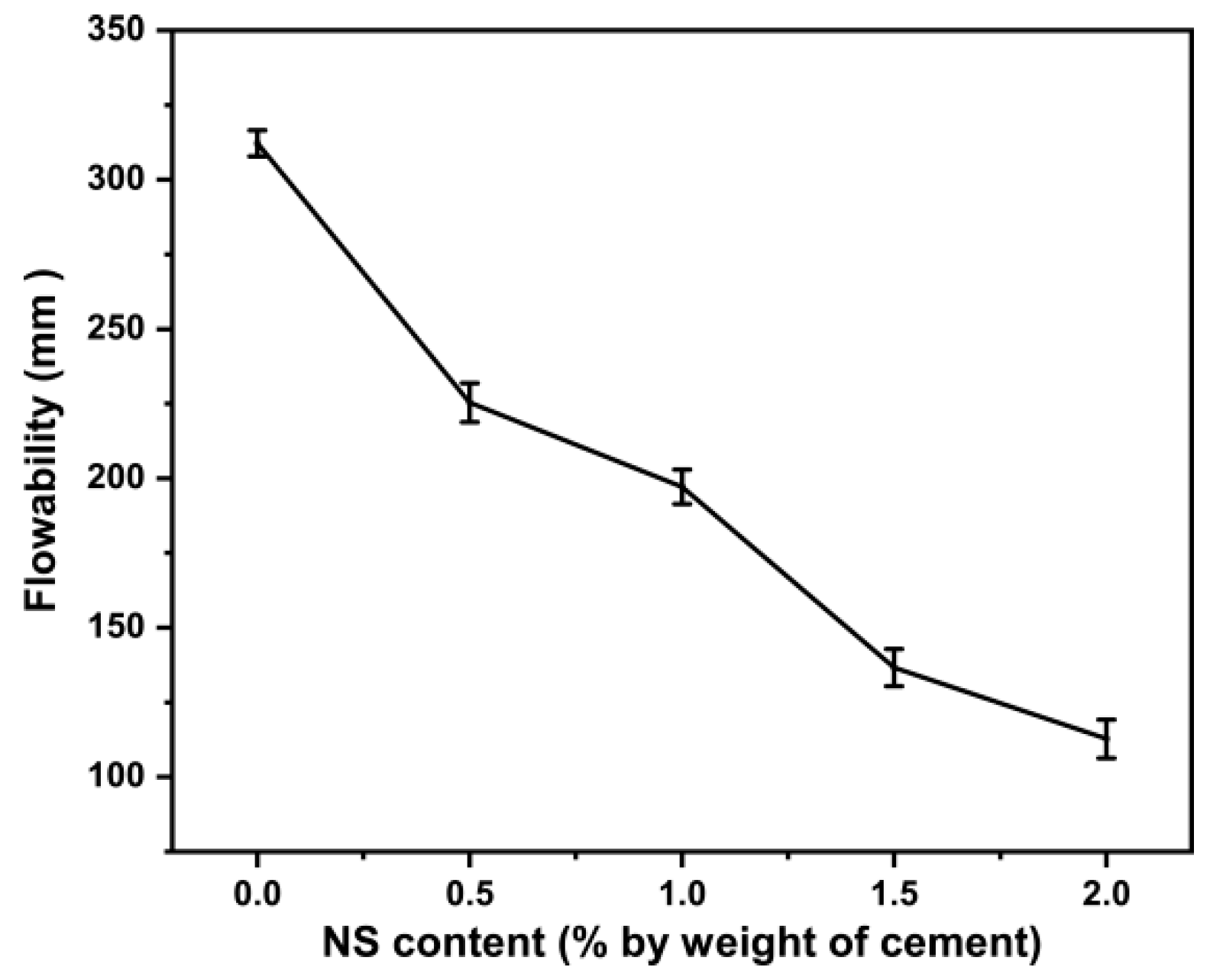

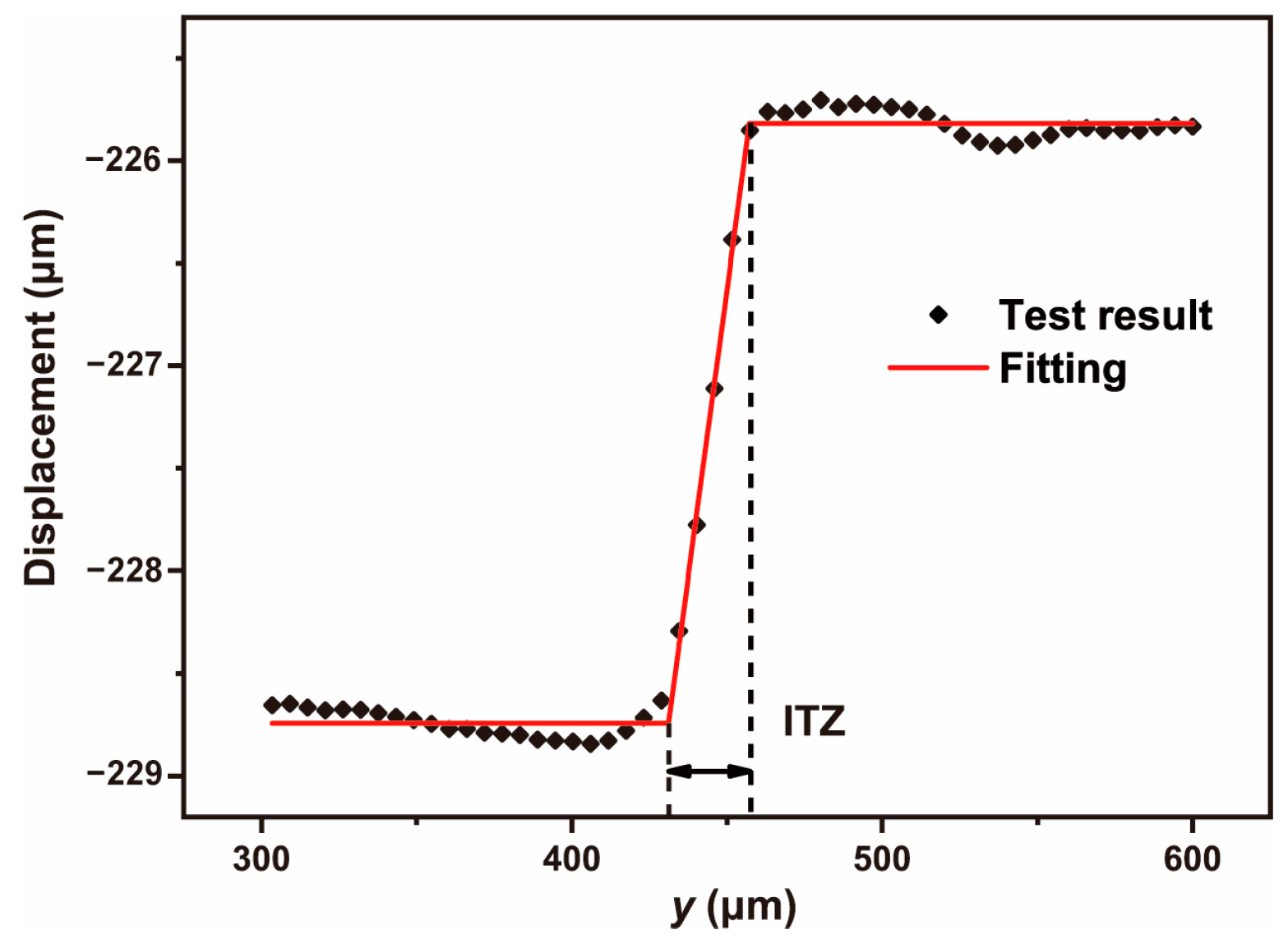



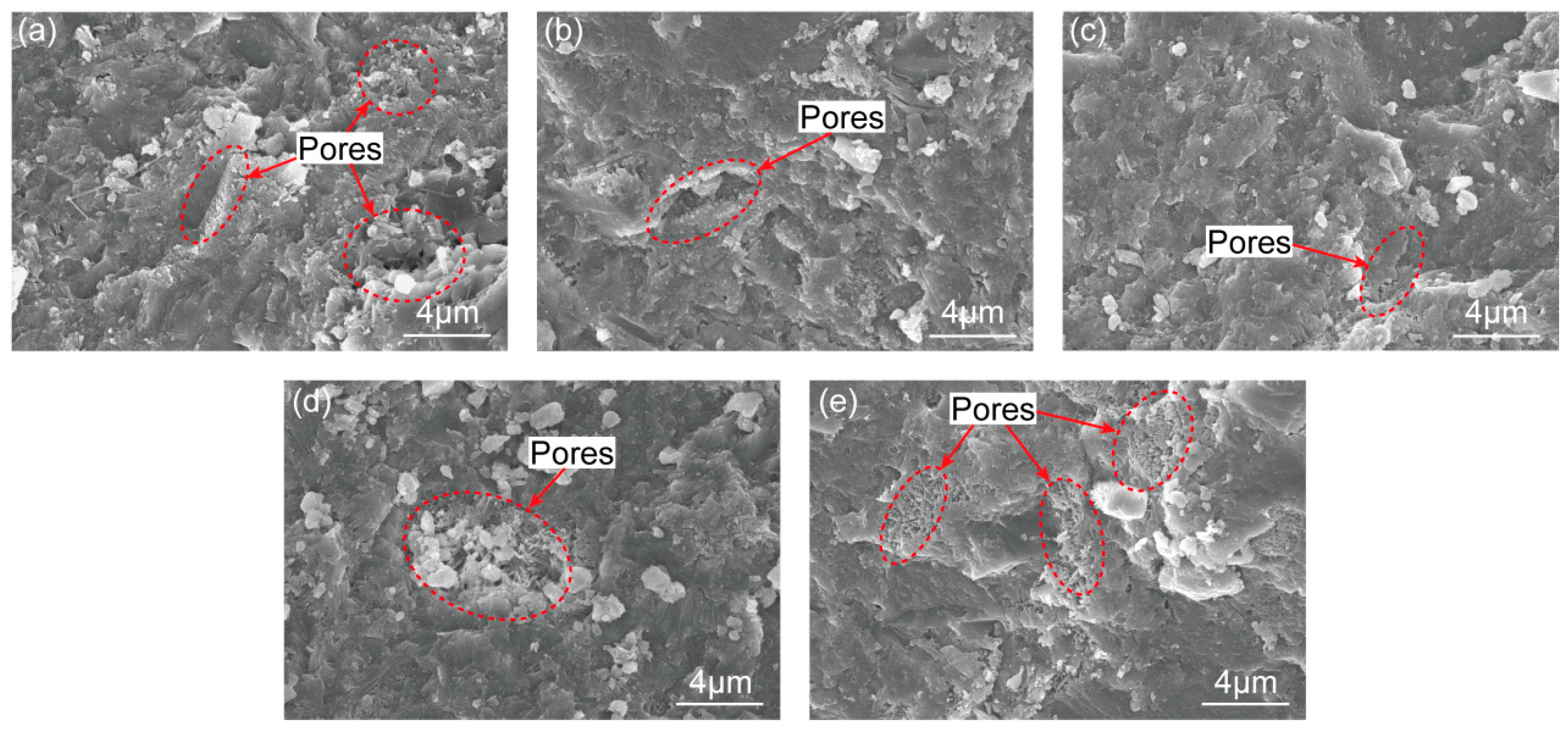

| Oxides | Other Components | Ignition Loss | |||||
|---|---|---|---|---|---|---|---|
| SiO2 20.96 | Al2O3 4.13 | Fe2O3 3.03 | CaO 62.32 | MgO 2.90 | SO3 2.38 | 1.436 | 2.14 |
| Specific Surface Area (m2/kg) | Density (kg/m3) | Standard Consistency (%) | Setting Time (min) | Flexural Strength (MPa) | Compressive Strength (MPa) | |
|---|---|---|---|---|---|---|
| 358 | 3110 | 26.00 | Initial | Final | 3 days 5.9 | 3 days 28.0 |
| 107 | 167 | |||||
| Diameter (nm) | Surface-to-Volume Ratio (m2/g) | Density (g/cm3) | Purity (%) |
|---|---|---|---|
| 50 | 210 | 2.41 | 99.9 |
| No. | w/b | Mix Proportion of the Specimens | |||
|---|---|---|---|---|---|
| Water (g) | Cement (g) | NS (g) | Superplasticizer (% by Weight of Cement) | ||
| NS0 | 0.5 | 225 | 450 | - | 0.5 |
| NS0.5 | 0.5 | 225 | 447.75 | 2.25 | 0.5 |
| NS1 | 0.5 | 225 | 445.5 | 4.5 | 0.5 |
| NS1.5 | 0.5 | 225 | 443.25 | 6.75 | 0.5 |
| NS2 | 0.5 | 225 | 441 | 9 | 0.5 |
| NS Content (% by Weight of Cement) | 0 | 0.5 | 1.0 | 1.5 | 2.0 |
|---|---|---|---|---|---|
| Mean | 13.82 | 17.45 | 22.79 | 21.80 | 19.76 |
| Standard deviation | 7.70 | 9.01 | 11.70 | 10.11 | 7.40 |
| Minimum | 3.38 | 5.18 | 5.67 | 6.09 | 5.99 |
| Median | 12.08 | 15.27 | 20.95 | 19.93 | 19.79 |
| Maximum | 31.61 | 38.13 | 49.33 | 42.32 | 36.99 |
| Interquartile range (Q3–Q1) | 10.82 | 15.33 | 18.64 | 13.82 | 9.34 |
| Range (Maximum–Minimum) | 28.23 | 32.95 | 43.66 | 36.23 | 30.99 |
| NS Content (% by Weight of Cement) | 0 | 0.5 | 1.0 | 1.5 | 2.0 |
|---|---|---|---|---|---|
| Mean | 1.82 | 2.83 | 3.36 | 2.90 | 2.81 |
| Standard deviation | 0.55 | 0.67 | 0.67 | 0.95 | 0.73 |
| Minimum | 1.06 | 1.30 | 2.34 | 1.38 | 1.88 |
| Median | 1.68 | 2.70 | 3.20 | 3.01 | 2.54 |
| Maximum | 2.90 | 4.74 | 4.80 | 5.18 | 4.75 |
| Interquartile range (Q3–Q1) | 0.86 | 1.07 | 1.05 | 1.32 | 1.00 |
| Range (Maximum–Minimum) | 1.84 | 3.44 | 2.46 | 3.80 | 2.88 |
| NS Content (% by Weight of Cement) | 0 | 0.5 | 1.0 | 1.5 | 2.0 |
|---|---|---|---|---|---|
| Mean | 91.38 | 76.91 | 84.25 | 81.80 | 84.71 |
| Standard deviation | 27.07 | 13.13 | 10.44 | 18.09 | 32.65 |
| Minimum | 49.98 | 55.55 | 62.11 | 56.39 | 35.45 |
| Median | 88.36 | 76.83 | 84.21 | 77.84 | 84.57 |
| Maximum | 144.34 | 102.98 | 103.14 | 119.63 | 151.16 |
| Interquartile range (Q3–Q1) | 44.63 | 19.94 | 13.91 | 25.92 | 60.93 |
| Range (Maximum–Minimum) | 94.36 | 47.43 | 41.03 | 63.24 | 115.71 |
Disclaimer/Publisher’s Note: The statements, opinions and data contained in all publications are solely those of the individual author(s) and contributor(s) and not of MDPI and/or the editor(s). MDPI and/or the editor(s) disclaim responsibility for any injury to people or property resulting from any ideas, methods, instructions or products referred to in the content. |
© 2023 by the authors. Licensee MDPI, Basel, Switzerland. This article is an open access article distributed under the terms and conditions of the Creative Commons Attribution (CC BY) license (https://creativecommons.org/licenses/by/4.0/).
Share and Cite
Zhang, S.; Liu, R.; Lu, C.; Hong, J.; Chen, C.; Xu, J. Influence of Nano-SiO2 Content on Cement Paste and the Interfacial Transition Zone. Materials 2023, 16, 6310. https://doi.org/10.3390/ma16186310
Zhang S, Liu R, Lu C, Hong J, Chen C, Xu J. Influence of Nano-SiO2 Content on Cement Paste and the Interfacial Transition Zone. Materials. 2023; 16(18):6310. https://doi.org/10.3390/ma16186310
Chicago/Turabian StyleZhang, Shaofeng, Ronggui Liu, Chunhua Lu, Junqing Hong, Chunhong Chen, and Jiajing Xu. 2023. "Influence of Nano-SiO2 Content on Cement Paste and the Interfacial Transition Zone" Materials 16, no. 18: 6310. https://doi.org/10.3390/ma16186310
APA StyleZhang, S., Liu, R., Lu, C., Hong, J., Chen, C., & Xu, J. (2023). Influence of Nano-SiO2 Content on Cement Paste and the Interfacial Transition Zone. Materials, 16(18), 6310. https://doi.org/10.3390/ma16186310






